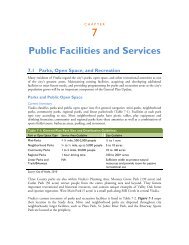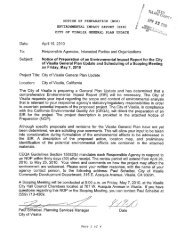General Plan Update Review Committee Draft Elements Part 2 For ...
General Plan Update Review Committee Draft Elements Part 2 For ...
General Plan Update Review Committee Draft Elements Part 2 For ...
You also want an ePaper? Increase the reach of your titles
YUMPU automatically turns print PDFs into web optimized ePapers that Google loves.
Groundwater Recharge. The natural process of<br />
infiltration and percolation of rainwater from land<br />
areas or streams through permeable soils into waterholding<br />
rocks that provide underground storage (i.e.<br />
aquifers).<br />
Habitat. The natural environmental of a plant or<br />
animal.<br />
Hazardous Material. A material or form of energy<br />
that could cause injury or illness to persons, livestock,<br />
or the natural environment. Some examples<br />
from everyday life include, gasoline, fertilizers,<br />
detergent, used cooking oil, mineral spirits, batteries,<br />
and paint.<br />
Hazardous Waste. Waste which requires special handling<br />
to avoid illness or injury to persons or damage<br />
to property. Includes, but is not limited to, inorganic<br />
mineral acids of sulfur, fluorine, chlorine, nitrogen,<br />
chromium, phosphorous, selenium and arsenic and<br />
their common salts; lead, nickel, and mercury and<br />
their inorganic salts or metallo-organic derivatives;<br />
coal, tar acids such as phenol and cresols and their<br />
salts; and all radioactive materials.<br />
Historic Resource. A historic building or site that<br />
is noteworthy for its significance in local, state,<br />
national, its architecture or design, or its works of<br />
art, memorabilia, or artifacts.<br />
Historic Structure. A structure deemed to be historically<br />
significant based on its visual quality, design,<br />
history, association, context, and/or integrity.<br />
Household. An occupied housing unit.<br />
Impact Fee. A fee, also called a development fee, levied<br />
on the developer of a project by a city, county,<br />
or other public agency as compensation for otherwise-unmitigated<br />
impacts the project will produce.<br />
California Government Code § 54990 specifies that<br />
development fees shall not exceed the estimated reasonable<br />
cost of providing the service for which the<br />
fee is charged. To lawfully impose a development<br />
fee, the public agency must verify its method of calculation<br />
and document proper restrictions on use of<br />
the fund.<br />
Impervious Surface. Any material which reduces or<br />
prevents absorption of water into land.<br />
Implementation. Actions, procedures, programs, or<br />
techniques that carry out policies.<br />
Infill. The development of new housing or other<br />
buildings on scattered vacant lots in a predominantly<br />
developed area or on new building parcels created by<br />
permitted lot splits.<br />
Infiltration. The introduction of underground water,<br />
such as groundwater, into wastewater collection systems.<br />
Infiltration results in increased wastewater<br />
flow levels.<br />
Infrastructure. Permanent utility installations,<br />
including roads, water supply lines, sewage collection<br />
pipes, and power and communications lines.




